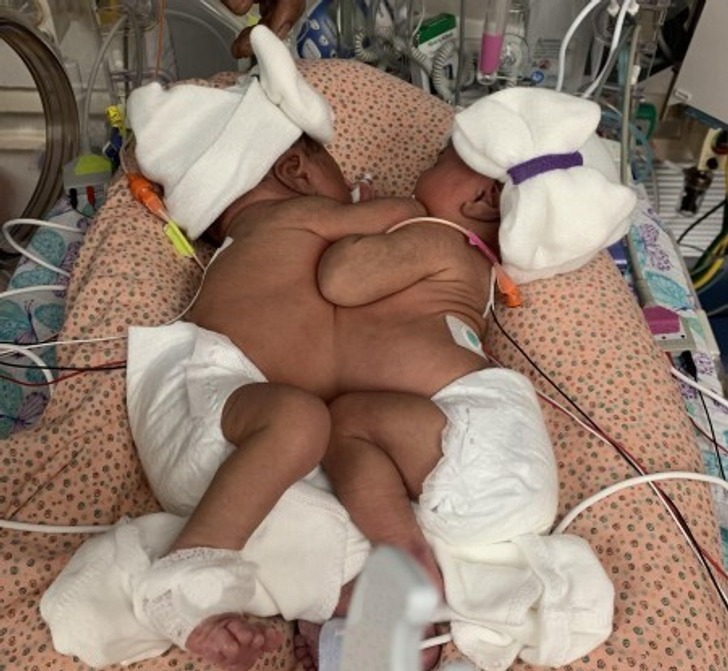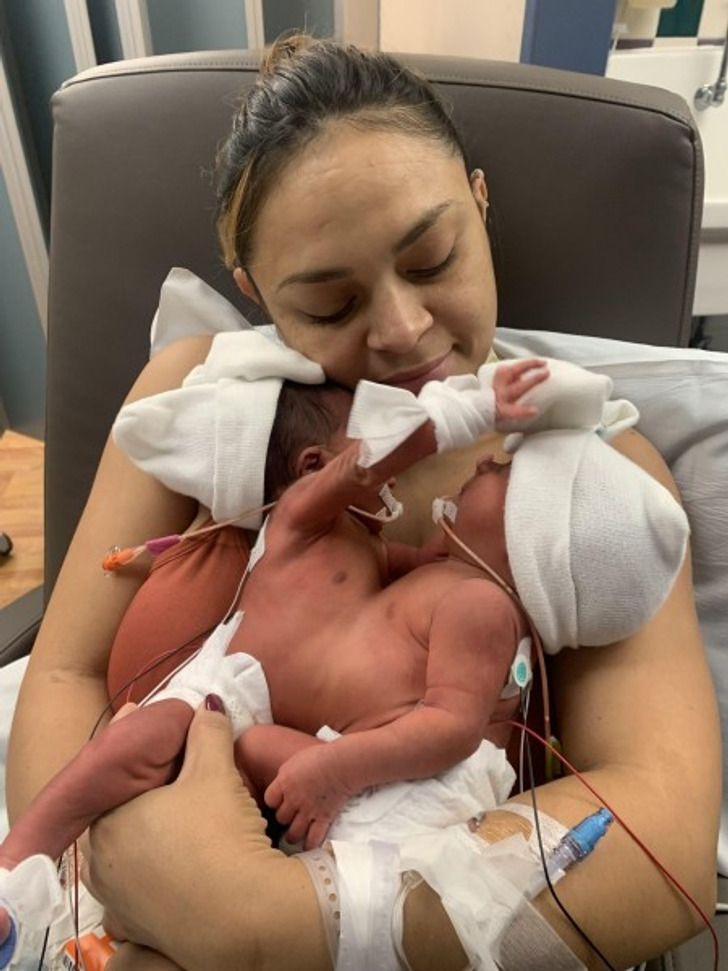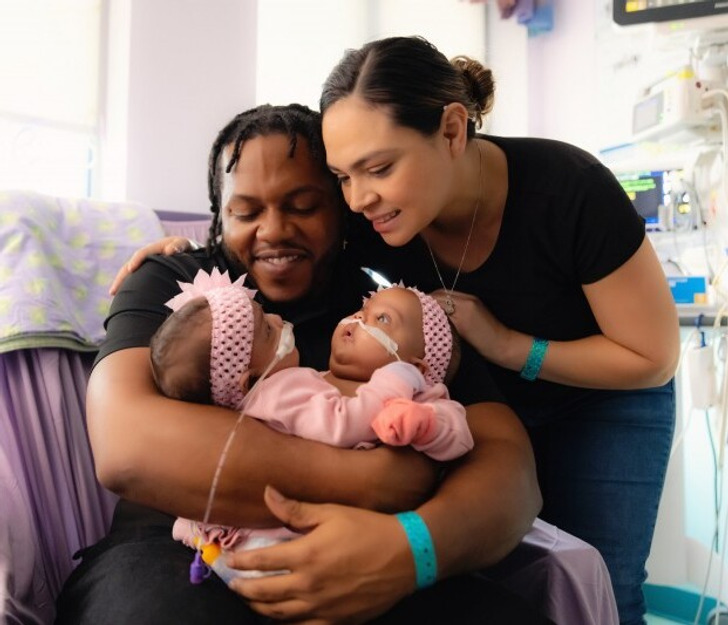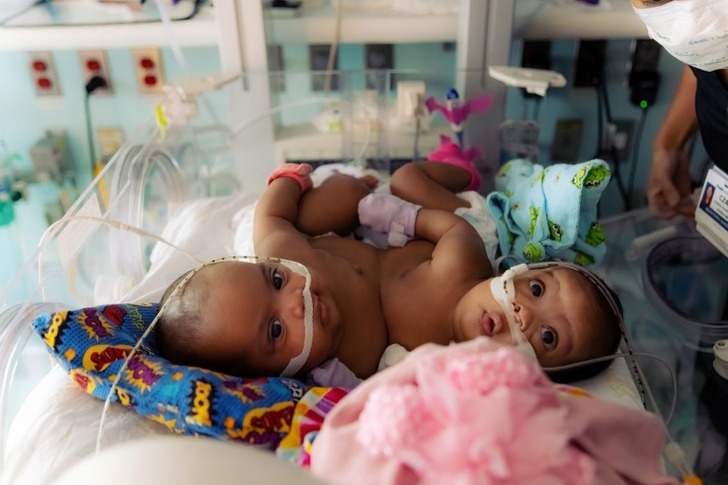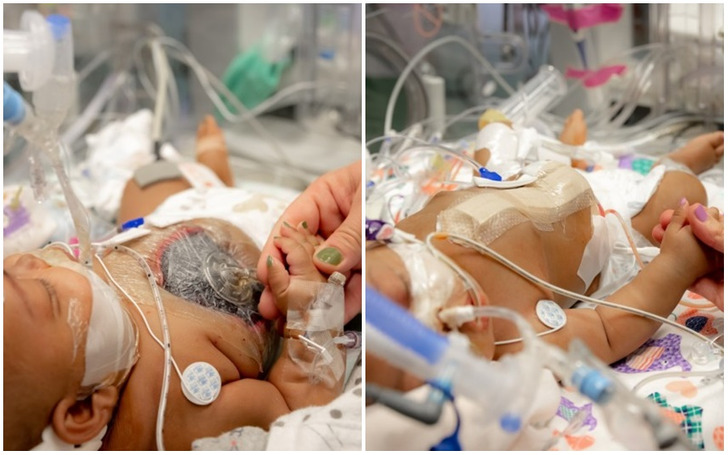Bless these little angels. I hope everything goes well for them and they continue to surpass and exceed expectations. I wish them all the best this world has to offer.
A Hospital Successfully Separated Conjoined Twins After an 11-Hour Surgery
Conjoined twins, specifically those who are joined at the abdomen and share a liver, are an exceptionally rare occurrence. The chance of them being born is estimated at only 1 in every 200,000 live births. Dr. Jose Iglesias, the medical director of pediatric surgery at Cook Children’s Hospital, explains that there are typically only 5 to 8 cases per year worldwide where conjoined twins survive and remain viable after birth. Thus, the rarity of such cases cannot be overstated.
The couple found out they were expecting conjoined twins at 10 weeks.
This unexpected news overshadowed the family’s initial excitement of welcoming 2 new members with a shroud of uncertainty, fear, and numerous unanswered questions. Arciniega, the mother, expressed her astonishment, stating that she never could have imagined having twins, let alone conjoined twins. Throughout the following months, she experienced a relatively smooth and uncomplicated pregnancy, apart from frequent visits to specialists across the state.
Conjoined twins often face significant challenges, with many not surviving in utero or succumbing shortly after birth due to the complexities associated with their shared organs and joining. However, scans revealed that JamieLynn and AmieLynn possessed individual hearts and heart sacs, thereby increasing their chances of survival and making them potential candidates for future separation.
When the babies were born
On October 3, 2022, at 34 weeks into the pregnancy, JamieLynn and AmieLynn were delivered via C-section at Texas Health Fort Worth at 10:40 a.m. Due to safety concerns, Arciniega underwent a vertical incision instead of the traditional horizontal approach. Both babies weighed 4 pounds and 7.8 ounces, with JamieLynn measuring 16.9 inches in length and AmieLynn measuring 16.5 inches.
Although the girls were thriving in the Neonatal Intensive Care Unit (NICU), they weren’t growing at the same rate, partly because of their shared blood supply. Dr. Barber explained that one twin was essentially “stealing groceries” from the other. Additionally, AmieLynn was starting to develop scoliosis.
Feeding the twins has become increasingly challenging due to their size, mobility, and close proximity to each other. While their hearts are separate, they are positioned remarkably close together and continue to grow closer as the girls age. At almost 4 months old, the timing for the separation surgery was deemed appropriate.
However, the procedure carried significant risks and uncertainties. The liver, being a highly vascular organ, posed a potential bleeding risk during dissection. Moreover, there was a considerable risk of infection, which was closely monitored during the weeks of recovery. The doctors were uncertain how the babies’ hearts would respond to their new anatomical position, as this was the first time they would lie on their backs.
Finally, the separation begins.
Inside the operating room, a team of medical professionals assembled, including 3 anesthesiologists, 4 pediatric surgeons, 2 plastic surgeons, and numerous other clinical experts. They divided into 2 teams, each dedicated to one of the girls. The initial hours of the procedure involved the placement of central lines for anesthesia delivery and the insertion of breathing tubes.
Sedation was then administered in a deliberate and meticulous manner. Surgeons commenced by opening the abdominal wall, followed by dissecting the lower sternum and the liver. The long-awaited update arrived at 3 p.m., bringing the joyous news that JamieLynn and AmieLynn had been successfully separated and were lying on their backs. The room was filled with tears of relief and resounding cheers of praise from family and friends as the weight of anxiety dissipated.
The recovery process can be characterized as a gradual and patient journey. On the day of AmieLynn and JamieLynn’s surgery, it became apparent that their path to full recovery would involve comprehensive rehabilitation. This will encompass the expertise of nutritionists, physical therapists, occupational therapists, speech therapists, and other specialists.
While the doctors maintain an optimistic outlook, they remain cautiously hopeful, anxiously awaiting the moment when they will bid farewell to the girls as they embark on their first journey home from Cook Children’s Hospital.
And while medical miracles don’t happen every day, they still happen more often than we think. For example, one woman gave birth to quadruplets after having brain surgery, and another woman without ovaries gave birth to twins. In another extraordinary case, twins were born after just 126 days of being in their mother’s belly.
Comments
Related Reads
18 Women That Took Part in Transformation Shows and Became Completely New People

The World’s Most Expensive Wedding Cake Was Made in Dubai, and It’s Probably Worth Its Price
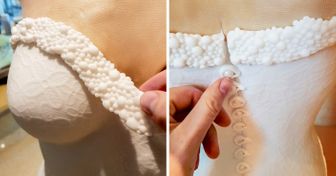
15 Photos That Show Sudden Moments Happen When You Least Expect Them

19 Famous People Who Honestly Showed What They Look Like When They’re Behind the Screens

What Moms of Gorgeous Celebrities Looked Like When They Were Young

20+ People That Wanted to Hack Life and Actually Did It

20 People Who Blossomed Into Their Full Glory at Age 30

Zac Efron’s Appearance a Few Days Ago Leaves Fans Shocked and Worried

Young Woman Documents Her Double Jaw Surgery, and Leaves Everyone Stunned With the Results

A Woman Used Botox Because She Wanted to Look Like Her Younger Self, and According to People Online She Succeeded

Sharon Stone, 65, Shares a Stunning Bikini Photo, But One Twist Completely Stole Her Thunder

Dylan Mulvaney, Transgender and Activist, Reveals Crazy Results of Her Facial Surgery

